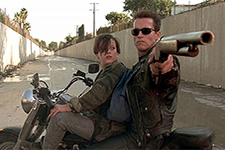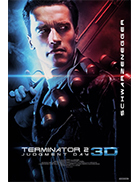Terminator 2: Judgment Day 3D
|  With its 3D theatrical re-release, James Cameron’s Terminator 2: Judgment Day is now both the best summer movie of 1991 and the best summer movie of 2017. A massive $102 million gamble at the time of its original release (the first Hollywood film ever to cross the $100 million budgetary threshold), T2 embodies all that is great about summer movie thrills while also weaving through the various chase scenes, shoot-outs, and massive billowing explosions a genuine sense of human feeling and moral concern, which is perhaps Cameron’s greatest asset as a filmmaker. Having literally exploded onto the scene in 1984 with The Terminator, Cameron cemented his status as a major director with Aliens (1986) and then almost lost it all on The Abyss (1989), a deeply troubled production that resulted in a great, misunderstood, and vastly underappreciated masterpiece. Thus, T2 was a kind of return to form for Cameron, reuniting him with Arnold Schwarzenegger, the Austrian bodybuilder whose Hollywood career took off along with Cameron’s when he was cast as The Terminator’s instantly iconic cyborg assassin. T2 was a shrewd commercial move, despite the dangerously enormous budget, although Cameron defied the safety set of a familiarly titled sequel and major star with a few calculated twists and a decidedly more thoughtful take on human violence. The screenplay, which was written by Cameron and William Wisher, follows the general beats of, and has the same stakes as, the original Terminator, but with some decided changes and elaborations. The story takes place a little over a decade after the events in the first movie, which found a Los Angeles waitress named Sarah Connor (Linda Hamilton) running for her life when she is targeted by Schwarzenegger’s cyborg Terminator sent back from the year 2029 to kill her because she will eventually give birth to the leader of the human resistance fighting against the machines that have taken over the planet following a nuclear holocaust. The target this time around is that future leader, John (Edward Furlong), who is now an 11-year-old juvenile delinquent living with a foster family (Jenette Goldstein and Xander Berkeley) because Sarah has been incarcerated in a mental institution following her attempt to blow up a computer factory (her seemingly psychotic stories about cyborgs from the future and impending nuclear war don’t help, either). As in the original, we see the electric arrival of Schwarzenegger’s Terminator, which for the film’s opening half hour we are cleverly led to believe is the same kind of towering, stone-faced assassin we met in the original film. And again he must procure clothing (you have to time-travel naked, you see), which he does from a biker bar conveniently located nearby. We also see the arrival of what at first appears to be a man (Robert Patrick) who we assume will be the resistance fighter sent to protect John. However, in a bravura sequence set in the utility hallways of a shopping mall, we learn that the set-up is, in fact, completely reversed. Schwarzenegger’s Terminator has been reprogrammed by John Connor in the future to protect his 11-year-old self while Patrick’s character is actually an even more dangerous and technologically advanced T-1000 Terminator that can melt and morph into various personas and transform parts of its body into blunt-force tools and stabbing weapons. The story develops into what is essentially an extended chase sequence, with John and the Terminator running from the T-1000 while also trying to fight the future by changing it. John insists that the Terminator aid him in freeing Sarah from the mental institution, after which they begin to plot first to kill and then to work with Miles Dyson (Joe Morton), the director of special projects at Cyberdyne who will be the primary brain behind creating Skynet, the defense system that will eventually launch a nuclear war against humanity. Sarah’s evolution from frightened would-be victim to hardened self-protector in The Terminator finds its logical conclusion in T2, where she has become an intense, glowering hardbody whose girlish preoccupations at the beginning of the first movie are little more than a distant memory. Forced by circumstance to be both a survivor and a protector, she is a fascinating figure who Hamilton plays with both conviction and compassion. The weight of knowing the future and the violent end to which humanity will be subjected wears on her terribly, and Cameron shows us her nuclear nightmares, first as an abstract opening credits sequence and later as a direct engagement with her deepest fear—that she knows what will happen and will be unable to stop it. Sarah Connor is, in many ways, an extension and elaboration of Ripley (Sigourney Weaver) from Cameron’s Aliens, a female hero whose actions are driven by a determined conviction to protect, which cannot be untangled from her status as a mother. Sarah, however, is more complicated and difficult because her mental status is brought into question and her motherhood has been perverted to some degree by the dire situation she faces. She does not have the time nor space to be nurturing, but must rather channel all of her motherly instincts into training John to survive and lead, not just for his own sake, but for the sake of the human race, the core of which Cameron calls into question on several occasions. At one point, John watches two children play-fighting with guns and perceptively recognizes how their childish antics betray a deep-seated vein of inherent violence in the human condition. “We aren’t going to make it, are we?” he asks, to which the Terminator responds, “It’s in your nature to destroy yourselves.” That theme of human self-destruction had appeared in all of Cameron’s previous films: in the impending apocalypse of the original Terminator, in the destructive capitalism that promotes commodities over human lives in Aliens, and in the restored ending of The Abyss, which finds peaceful aliens threatening to wipe out humanity before we do it to ourselves. Yet, as in the previous films, Cameron seeks out glimmers of hope, which in T2 is embodied primarily in John’s ironic directive to the Terminator not to actually kill anyone, a moral imperative that the cyborg has obvious trouble comprehending. The value of individual human lives is central to T2, making it a uniquely morally minded summer blockbuster. The Terminator grows as a character, his newly programmed role as protector turning him into an unlikely father figure, something that Sarah sadly recognizes. Schwarzenegger has never been heralded as a particularly great actor, but his work here, as in the first movie, is subtly effective and all too easy to underappreciate; he is playing a machine that essentially learns to be human (he finally understands at the end why people cry), which makes his final sacrifice so emotionally compelling. It also gives T2 more room for humor, with John teaching the Terminator various bad-boy adolescent catchphrases that he is later able to incorporate into the action (“Hasta la vista, baby,” remains one of Schwarzenegger’s most indelible lines). Even the most obvious gags, such as Schwarzenegger stepping out of the biker bar in his newly acquired leather duds to the familiar guitar riffs of George Thorogood’s thoroughly overplayed “Bad to the Bone,” somehow work. Of course, what people often remember about Terminator 2 are the effects, and for good reason. Sandwiched between the water pseudopod in The Abyss and the dinosaurs in Steven Spielberg’s Jurassic Park (1993), the T-1000 was a jaw-dropping harbinger of things to come in terms of computer-generated imagery and the revolutionary impact it would have on special effects. Like the water pseudopod, the CGI in T2 didn’t so much replace conventional analog effects as it made possible what previously would have been impossible; there was simply no other way to create a character like the T-1000, one that could morph right in front of our ideas into various characters, whose metallic gunshot “wounds” melt away right in front of our eyes, and who could rise up out of the floor, walk through metal bars, and transform its hands into blades. I first saw Terminator 2 at a sneak preview a few days before it opened theatrically, and I have a distinct memory of wondering something that I, unfortunately, never get to wonder anymore at the movies: How did they do that? The effects were sublime, a revelation, and a shock all at the same time, although watching the movie today it is fascinating to realize how little the movie employs obvious CGI. Like the dinosaurs in Jurassic Park, the morphing T-1000 is so effective partially because it occupies minimal screen time so that its biggest moments have real, lasting impact. The CGI also co-exists with a cavalcade of traditional special effects—from backscreen projection, to motion-control miniatures, to Stan Winston’s prosthetic make-up effects, to good ol’ fashioned pyrotechnics, which at one point detonate an entire office building. Like the original, T2 is both fascinated with, and terrified of, technology, and the threat of computers and artificial intelligence (it is a computer, after all, that launches World War III) is balanced in the film visually by an intense focus on heavy machinery and artillery—the technologies of the 20th century that are put to use in the future to fight the battles of the 21st. Thus, we get not one, but two major chase sequences involving enormous rigs, a climax that takes place in a fiery steel plant, and a desert hideaway in which an underground bunker houses all manner of bombs and guns. Cameron has an innate sense of the spectacular, and more so than most commercial filmmakers, he recognizes the importance of tonal balance and the need for his massive setpieces to coexist within a meaningful narrative, intriguing characters, and fully developed themes (something that Michael Bay has never figured out). Watching Terminator 2 for the first time in years, it is obvious that Cameron understood that what makes thrilling movies great is not just the thrills, but that the thrills have real meaning. Copyright © 2017 James Kendrick Thoughts? E-mail James Kendrick All images copyright © Studio Canal |
Overall Rating: 


 (4)
(4)


